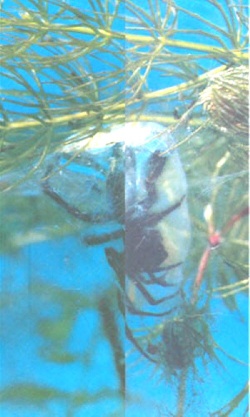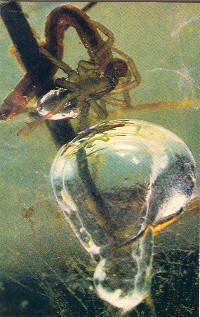
Jane Burton — Bruce Coleman, Inc.
|
Silently and stealthily the hungry skin diver, his portable air breathing equipment securely attached, inched along. A suspicious movement in the water ahead suddenly arrested his attention. Quickly he lunged toward the spot of the disturbance and came away with his prey — an inch — long guppy, more than enough for a sumptuous meal back at his submerged diving bell.
Lloyd Bridges or Jacques Cousteau he's not. But he's been at it a lot longer than any of his human counterparts. He's Argyroneta aquatica, an air-breathing spider who spends most of his life submerged in shallow ponds and streams in Europe and Asia. From the day he leaves the egg, Argyroneta is off and swimming with a tiny air bubble attached to his abdomen. When his air supply is depleted, he will rise to the surface, firmly grasp a new bubble between his legs and abdomen, and quickly re-submerge. This air gathering technique also comes in handy when Argyroneta decides to build his underwater home. He first begins by spinning a silk canopy that is anchored to various roots and twigs along the bottom. Then Argyroneta will surface, do his air-gathering routine, return and release his bubble under the canopy. After a number of such trips his canopy will be sufficiently inflated to form a comfortable underwater air bell. If space is available, Argyroneta may even construct two separate bells — one as a summer residence and the other for a winter home. During mating season, male and female spiders may even build a silken tunnel to link "honeymoon" bells. After fertilization, the female will then install an upper story in hers to act as a brood chamber. When the young spiders hatch they will gnaw through the canopy that covers the chamber, and set out with tiny air bubbles to explore their fascinating underwater world.
|
Since spiders don't come equipped with gills, it would seem the last place one would attempt to survive would be underwater! And even assuming in some million-to-one long shot that spiders on land found an underwater existence more comfortable, the problems they would have to overcome in adapting themselves to it would be staggering.
How, for instance, would they learn to use portable aqualungs and submerged diving bells complete with silken canopies, anchor lines and brood chambers?
Humans, even with their superior intelligence, had been unable to master similar techniques until comparatively recent times. With their limited intelligence, can it — does it — seem reasonable that spiders could have stumbled on such sophisticated submarine survival strategies on their own? Doesn't the behavior of Argyroneta aquatica cry out for the existence of a higher creative intelligence who knows what it takes to make a successful eight-legged skin diver?
Design in nature is one of the great attributes of all creation. Our free booklet, A Theory for the Birds, takes a look at the marvels of bird flight. Why not write for your free copy?

Dr. Frieder Sauer — Bavaria-Verlag
|
UNDERWATER AIR BUBBLES THAT DON'T BURST:
Argyroneta aquatica shows how it's possible for a lowly spider to spend practically its entire existence submerged in shallow ponds and streams.
In the top photo , Argyroneta is comfortably ensconced inside its airy domicile with its abdomen (center of its breathing apparatus) surrounded by air.
In the left photo, Argyroneta is shown perched next to his underwater lair, clutching his portable air supply or "aqualung" along with recently captured prey. Note how the larger air bubble is anchored with a network of silken strands. Spiders eat, breed, and raise young inside their bubbles.
|